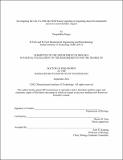Investigating the role of a JNK-like MAP kinase signaling in regulating dauer developmental arrest in Caenorhabditis elegans
Author(s)
Dogra, Deepshikha
DownloadThesis PDF (3.765Mb)
Advisor
Kim, Dennis H.
Terms of use
Metadata
Show full item recordAbstract
Many metazoans have the ability to respond to stressful growth environments by arresting in a diapause state. The young larvae of nematode Caenorhabditis elegans undergo drastic anatomic and metabolic remodeling to enter a developmental diapause called dauer in response to crowding, diminished food and elevated ambient temperature. The experimental studies of dauer formation have advanced our understanding of how conserved neuroendocrine signaling regulates developmental plasticity. While the molecular basis of how C. elegans respond to high population density has been defined, the mechanisms by which food and temperature regulate dauer entry are less well-known. This thesis identifies and characterizes the role of a stress-activated c-Jun Nterminal Kinase (JNK)-like mitogen activated protein kinase (MAPK), KGB-1, in dauer formation. In view of established roles of JNK MAPK in stress-activated signal transduction, the identification of the KGB-1 pathway in regulating dauer diapause is remarkable since dauer entry represents one of the most dramatic and organism-wide stress responses. In this thesis, we will review the genetic and cellular basis of the C. elegans dauer developmental decision, the neuroendocrine signaling pathways that regulate dauer arrest, and the role of MAPK pathways in stress response. We show that the KGB-1 pathway functions in the sensory neurons and acts in parallel to the TGF-beta and insulin signaling pathways. We demonstrate that increased activation of the KGB-1 pathway can substitute for diminished food and elevated temperature in triggering dauer entry, cementing its role in transduction of these environmental cues. Finally, we characterize the interaction of the KGB-1 pathway with other signaling pathways in dauer formation and analyze known upstream regulators and downstream targets of KGB-1. Future directions are included which aim to advance our understanding of neuroendocrine regulation of stress physiology in animals with C. elegans as a model.
Date issued
2021-09Department
Massachusetts Institute of Technology. Department of BiologyPublisher
Massachusetts Institute of Technology